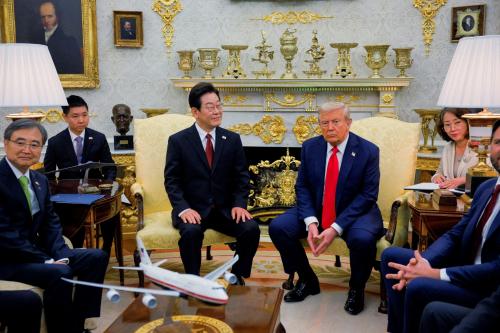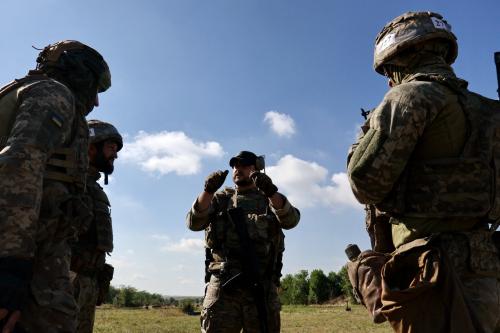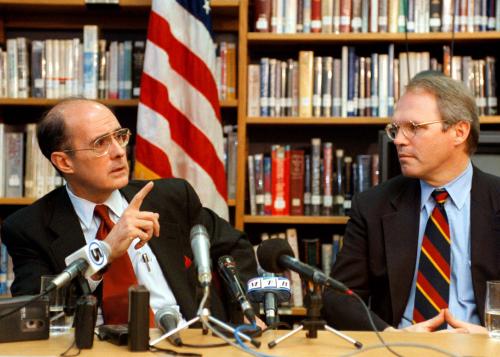Russia today poses a greater foreign policy and security challenge to the United States and its Western allies than at any time since the height of the Cold War. Its annexation of Crimea, war in Ukraine’s Donbas region, and military intervention in Syria have upended Western calculations from Eastern Europe to the Middle East. Russia’s intervention in Syria, in particular, is a stark reminder that Russia is a multi-regional power—as much by intent as by geography.
Under- or overestimating Russia’s capabilities—and those of Russian President Vladimir Putin—can lead to dangerous policy miscalculations and strategic surprises. If the United States and its allies are not to be continually surprised, we will have to put more resources behind understanding what is happening inside Russia, as well as analyzing the complex of Russia’s interactions internationally. We need a more holistic approach if we are to succeed in identifying workable policy solutions.
Russia’s military momentum
Putin’s current challenge is to maintain the military momentum Russia first gained with its war against Georgia in August 2008, and to keep taking the West by surprise, as it has in both Ukraine and Syria. Russia may, however, be coming to its limits for conducting larger-scale military operations. In Ukraine, part of the impetus for dampening down the conflict over the last several weeks—along with securing sanctions relief and pocketing gains on the ground—is that the war in the Donbas region has been relatively costly in the context of Russia’s partially-implemented rearmament program, which did not really begin until 2011. The current Russian economic downturn, created by a confluence of plummeting energy prices and Western sanctions, has squeezed Russia’s defense budget. Indeed, Western sanctions (enhanced in the wake of the 2014 shoot-down of the Malaysian airliner by Russian rebels) hit Russia just as the efforts to reinvigorate Russia’s defense industry hit their stride, depriving Russia of access to critical foreign technology and budget revenues.
The intervention in Syria has further compounded the military’s replacement problem. The costs of the Syrian campaign are difficult to calculate—they are not just the total of the Russian military’s declared costs, which seem quite low. But, the Syrians are not paying for the armaments and assistance they receive from Russia.
Russia’s dilemma is now one of prioritization.
Russia’s dilemma is now one of prioritization—where to allocate its budget, and where and how to deploy its (relatively limited) trained manpower. Russian military planners are still absorbing the impact of economic decline on their resources. Beyond the limits of men and materiel, they are also (like Western military planners) uncertain about what might come next in the international arena. For Russia and the Putin team, being at war in the Middle East is unfamiliar territory. This is a very different kind of intervention from Georgia and Ukraine, and from Russia’s own civil wars with Chechnya. Russia’s goal in Syria is to consolidate the Assad regime’s position on the ground to ensure Bashar Assad’s hold on to power until a better arrangement is devised through international negotiations—with Moscow in a lead position (as Putin has insisted from the start of the war). Intervening in Syria to achieve this goal was a high-stakes gambit. It requires many other players—not just the United States—to play along with Moscow, on the ground and at the negotiating table.
In the case of Ukraine, since March 2014 Russia has vacillated between and among applications of military force, economic pressure, and political negotiations—with the Ukrainians, with Europeans, and with the United States (over the heads of everyone else). Moscow is constantly testing to see which avenue is most promising at a particular juncture to press Russia’s advantage, and to ensure it can always leave its options open.
To Putin’s chagrin, there has been no replay of the bloodless seizure of Crimea—he has not managed to secure a quick military victory in the Donbas. There will similarly be no easy victory in Syria, where the risks increase every day. Turkey’s shoot-down of a Russian plane in November 2015 provoked a serious rift between Moscow and Ankara. There are a lot more things that can go wrong in both Ukraine and Syria.
Keeping up appearances
At all turns, Putin has shown he is willing to take the risk that things will go wrong, and to pay a high economic and diplomatic price as he seeks to tip regional balances of power in Europe and the Middle East in Moscow’s favor. He has upset the “reset” of relations with the United States, lost “modernization partnerships” with Germany and the European Union, and ruptured relations with NATO. Many of Russia’s other foreign relationships are also strained.
How long can this continue? Can Putin keep the population mobilized behind his presidency if things start to go badly wrong for the Russian military operation in Syria? You can be sure that Vladimir Putin is also considering this question carefully.
The legitimacy of the current Russian political system depends almost entirely on the maintenance of Putin’s charismatic authority and his record as a leader. If the Russian people lose their faith in Putin as president, then the whole political system risks becoming destabilized.
Putin and his team have been able to blame all of Russia’s woes on the United States and on Western actions and sanctions.
With the economic downturn, Putin and his inner circle are under pressure to keep delivering foreign policy victories, which have boosted Putin’s popularity in Russia. His approval rating has hovered around 90 percent, in part because of the siege mentality that has progressively taken hold in Russia, but also because the Russian public generally supports Putin’s display and use of force to assert Russia’s foreign policy interests. Public opinion surveys show a broad-based conviction among Russians that the United States and the West are “out to get them.” In the context of the Ukraine crisis and the war in Syria, this has given Putin a clear—but temporary—advantage.
Although the Russian economy and the state budget have taken a beating since 2013, the wars have helped to deflect public attention away from economic and political demands. Putin and his team have been able to blame all of Russia’s woes on the United States and on Western actions and sanctions.
Playing the long game
Ultimately, in pursuing Russia’s goals, Putin is a pragmatist. He has to keep a watchful eye on the home front, and Russia does not have the military or economic resources for the mass-army, total mobilization approach that it adopted during the Cold War to defend itself against the United States and NATO. Putin has to combine conventional, nuclear, and non-conventional, non-military—so-called “hybrid”—means of defense. Russia’s military modernization program has been geared toward this.
[T]he security response to the Russian challenge will have to encompass the arc of a long game.
Putin has also applied his operative’s approach, as a former KGB agent, to thinking about how to deter the United States and its allies from considering taking any military action against Russia—in Ukraine, Syria, or elsewhere. He has put everything on the table, showing that Russia has the capacity to act and the will to escalate. Nuclear weapons only have real deterrent value if they can be instrumentalized like the rest of the Russian military—so, Putin and his team are drawing up a contingency for deploying Russia’s nuclear arsenal in some way. The goal is to push the United States and NATO away from Russia and out of its neighborhood, not actually to engage in a nuclear exchange.
All this makes it tricky for the United States to devise strategies and policies for dealing with Russia. Given all the factors at work in Russia and the international arena—including the informal nature of power and the role of personalized politics in Moscow, as well as Putin’s operative thinking about the Russian military and nuclear arsenal—the U.S. security response to the Russian challenge will have to encompass the arc of a long game. Strategic patience must accompany the judicious balance of elements of deterrence, defense, and constraint, along with clear incentives and direct engagement with Putin and his inner circle.
We need to understand the nature of Russian threat perceptions and Russia’s long-term perspectives. Managing the U.S.-Russia relationship will require a considerable attention inside and outside government, and close coordination with our allies on analysis and policies.
Note: This post is abridged and adapted from testimony delivered to the House Armed Services Committee on February 10, 2016.
The Brookings Institution is committed to quality, independence, and impact.
We are supported by a diverse array of funders. In line with our values and policies, each Brookings publication represents the sole views of its author(s).




Commentary
Russian adventurism and the U.S. long game
March 3, 2016